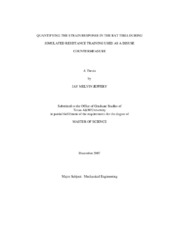| dc.contributor.advisor | Bloomfield, Susan A. | |
| dc.contributor.advisor | Hogan, Harry A. | |
| dc.creator | Jeffery, Jay Melvin | |
| dc.date.accessioned | 2010-01-15T00:02:52Z | |
| dc.date.accessioned | 2010-01-16T00:23:06Z | |
| dc.date.available | 2010-01-15T00:02:52Z | |
| dc.date.available | 2010-01-16T00:23:06Z | |
| dc.date.created | 2007-12 | |
| dc.date.issued | 2009-05-15 | |
| dc.identifier.uri | https://hdl.handle.net/1969.1/ETD-TAMU-2087 | |
| dc.description.abstract | Disuse of weight bearing bones has been shown to cause bone loss. This poses a
health concern for people exposed to microgravity, such as astronauts. Animal studies
are used to study factors related to bone loss and countermeasures to prevent bone loss.
This study used a hindlimb unloaded (HU) rat model to simulate microgravity and a
muscle stimulation countermeasure to simulate resistive exercise. Uniaxial strain gages
were implanted on the antero-medial aspect of the proximal tibia to measure the
mechanical strain during a typical exercise session.
In a separate but parallel study, the exercise was shown to be an effective
countermeasure to disuse related bone loss. The current study sought to understand the
loading of the bone during the exercise. To determine if the strain response changes
during a protocol using this countermeasure, strains were measured on a group of weight
bearing animals and a group that were hind limb unloaded and received the
countermeasure for 21 days. Strain magnitudes and rates were considered and related to
torques at the ankle joint. No significant differences in strain magnitudes were noted
between the baseline control group and the hindlimb unloaded group that received the
countermeasure.
The two kinds of contractions used in an exercise session are isometric and
eccentric. The isometric contractions are used to adjust the stimulation equipment for
the eccentric contractions, which constitute the exercise. Peak strain levels during the
isometric contractions ranged from 900 to 2200 microstrain while the eccentric were
38% lower and ranged from 600 to 1400. Eccentric strain rates were 62% lower than the
isometric contractions strain rates. These results indicate that the strain environment during the isometric contractions may be causing more of the osteogenic response than
the eccentric contractions, which have previously been thought to be the primary part of
the countermeasure. | en |
| dc.format.medium | electronic | en |
| dc.format.mimetype | application/pdf | |
| dc.language.iso | en_US | |
| dc.relation.uri | https://hdl.handle.net/1969.1/85851 | |
| dc.subject | Strain | en |
| dc.subject | Rat | en |
| dc.subject | Disuse | en |
| dc.subject | Bone | en |
| dc.subject | Tibia | en |
| dc.subject | Mechanics | en |
| dc.subject | Biomechanics | en |
| dc.subject | Exercise | en |
| dc.subject | Muscle stimualtion | en |
| dc.title | Quantifying the strain response in the rat tibia during simulated resistance training used as a disuse countermeasure | en |
| dc.type | Book | en |
| dc.type | Thesis | en |
| thesis.degree.department | Mechanical Engineering | en |
| thesis.degree.discipline | Mechanical Engineering | en |
| thesis.degree.grantor | Texas A&M University | en |
| thesis.degree.name | Master of Science | en |
| thesis.degree.level | Masters | en |
| dc.contributor.committeeMember | Muliana, Anastasia | |
| dc.type.genre | Electronic Thesis | en |
| dc.type.material | text | en |
| dc.format.digitalOrigin | born digital | en |


